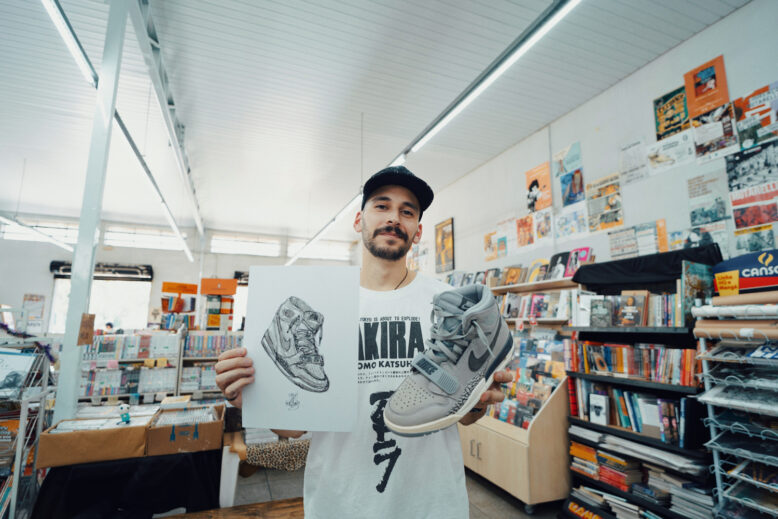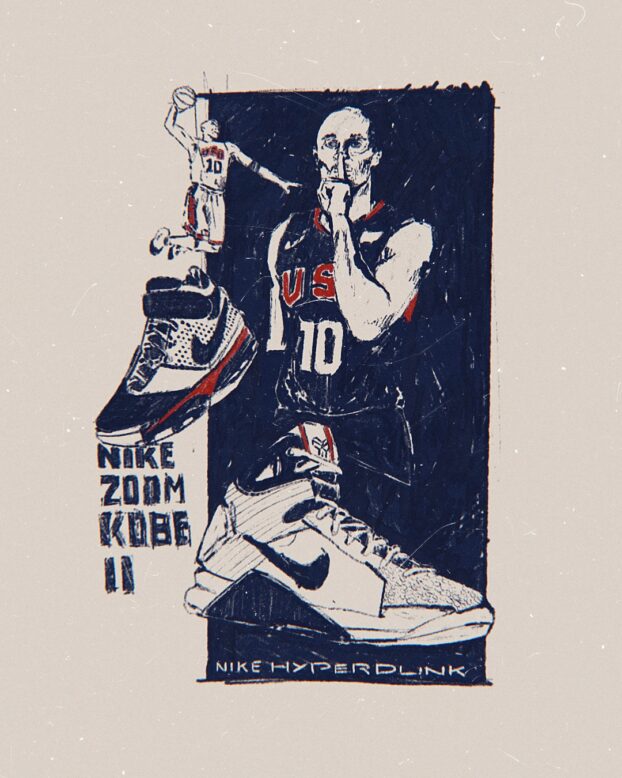
As the founders of basketball, it is part of America’s honor to be the most successful team in the history of the sport, and they are. Altogether, the American men’s and women’s basketball teams hold a combined 32 Olympic medals, with seventeen golds for the men’s team and ten for the women’s. Both teams have medaled in every Olympic appearance. In addition to being the sport’s greatest champions, these teams have amassed numerous records that highlight their relevance to global basketball, such as the men’s team record for the longest winning streak in Olympic history in any team sport, which was broken this year by the American women’s basketball team with eight consecutive golds.
Photos and content: Kickstory
Copy: Pedro Pasa Mota and Kickstory
Editing: Kickstory
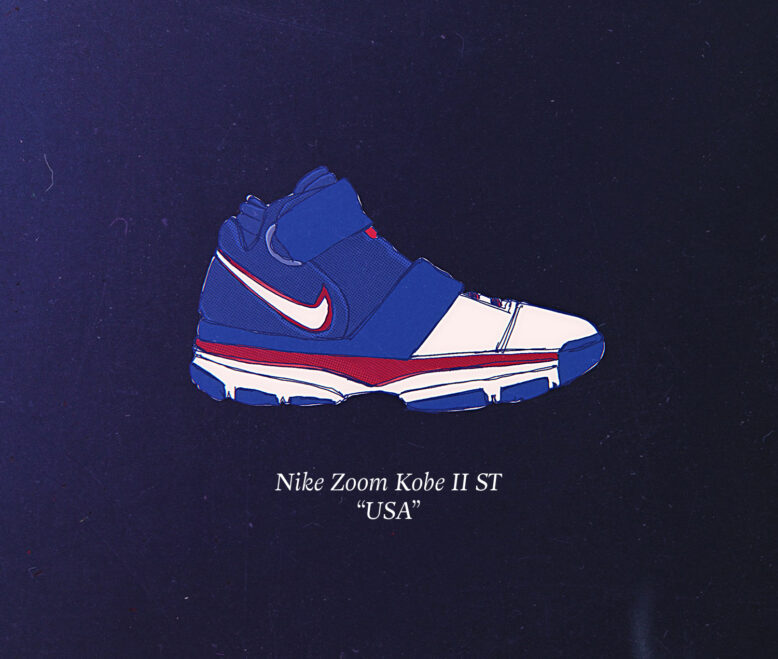
Nike Zoom Kobe 2
The 2007 FIBA Americas Championship marked Kobe Bryant’s first appearance playing for the U.S. national team. Kobe debuted two exclusive colorways in USA colors, each in a different version of the Zoom Kobe 2.
The second model in Kobe Bryant’s line with Nike, the Zoom Kobe II, was created by legendary sneaker designer Ken Link, who was also responsible for the Kobe I, II, LeBron Soldier I, II, and III, he was also involved in major projects like the Zoom Generation and other famous Nike models. Today, he serves as the design director at Under Armour, overseeing running, basketball, training, and Curry.
The Kobe II was conceived as a newer, lighter version of the famous Nike Zoom 2K4, incorporating some of the most advanced technology Nike had at the time for basketball. It featured a carbon plate to add stability and lightness for the shoes of one of the best basketball players of that era, a Zoom Air unit in the heel, and another in the forefoot, caged by a Cushlon midsole, which was used for the first time in a basketball shoe. Additionally, the segmented outsole was designed like a Nike Free model from that time, providing greater mobility. The shoe’s quality itself is something we rarely see today. It was made with different panels of leather, with various textures, and was part of Nike’s Considered project, a line of products that followed a manifesto of reducing materials and chemicals, a precursor to what would later become Move to Zero. The shoe didn’t have a single drop of glue in its upper; everything was stitched together, even the upper with the midsole.
Kobe stated that the inspiration for his second model came from a video he watched about orcas hunting in the wild, and how each one played a role within a hunting system they learned from a young age. Besides showcasing the agility, strength, and intelligence of these animals, the idea of having different versions tailored to each playing style also emerged.
The shoe had three versions, each for a different playing style:
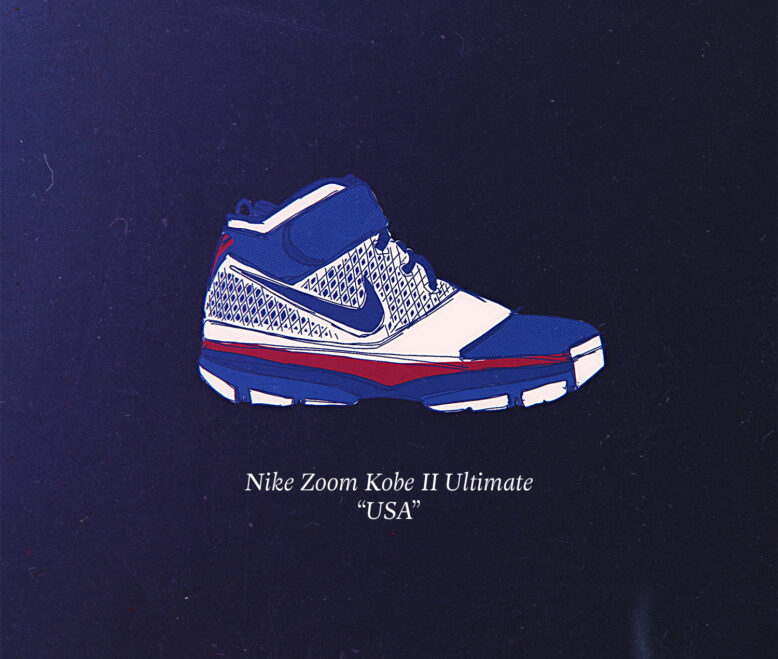
UltimateThe main version (Ultimate) featured a high-top design, an entire leather upper with a one-piece toe cap — similar to other Ken Link‘s designs at that time — along with a Strap for added support at the collar and a full length Zoom Air unit in the midsole.
StrengthThe ST version (Strength) added another Velcro strap in the midfoot for increased stability and control, as well as a Max Air unit in the heel to replace the Zoom Air. The ST version was the first to be released, in the ‘Orca’ colorway, one of the model’s most famous editions.
LiteThe Lite version aimed to simplify the shoe as much as possible, featuring a simple upper with fewer panels, highlighting the DNA of Nike’s classic basketball models, such as the Blazer and the Bruin, allowing the shoe to be worn both on and off the court. According to Kobe, the idea was to maintain simplicity and create a shoe specifically for playing basketball, with no distractions.

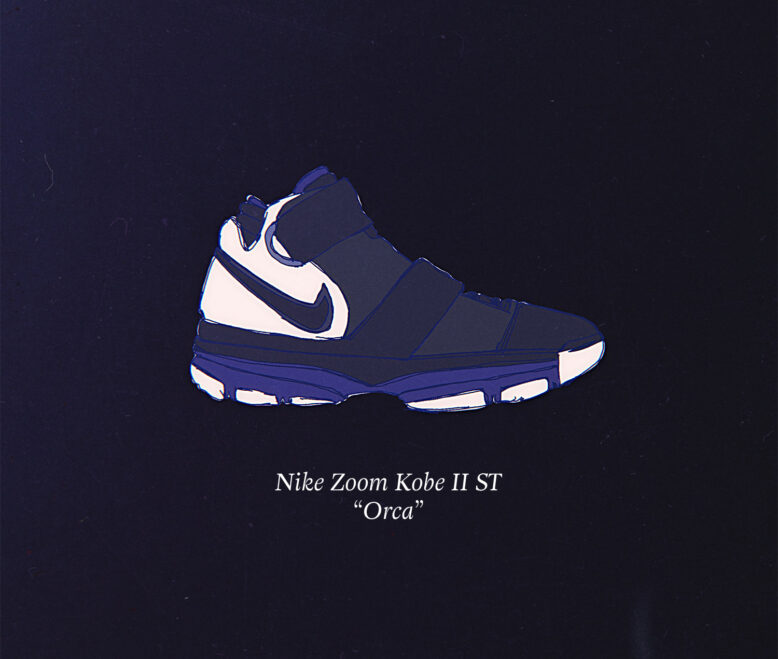
Nike HyperDunk 2008
For the 2008 Olympics, Kobe, coming off an MVP season, was not wearing his Nike Kobe III or the IV, which was yet to come. Kobe was the perfect athlete to showcase what Nike had innovatively created in a basketball shoe — the HyperDunk. The goal was to revolutionize the concept of a basketball shoe, and that’s exactly what Eric Avar, the designer behind most of the Kobe Bryant line, accomplished. He also created iconic models like the Zoom Flight 95, Air Penny, Foamposite, Nike Shox BB4, and many other brand icons.
The first major innovation of the shoe was Nike’s latest technology, inspired by the engineering of suspension bridges — Flywire. These small cables, when applied correctly, can support enormous weights, forming the foundation of the shoe.

By using Flywire to structure the shoe, Eric Avar realized he could eliminate other materials, significantly reducing its weight. Additionally, the HyperDunk was the first basketball shoe to introduce Lunarlon, Nike’s proprietary foam that is lightweight and responsive, inserted as a puck within the midsole at the forefoot. Both Flywire and Lunarlon would become the brand’s key technologies in the following five years, paving the way for the arrival of Flyknit, Nike’s technological knit.
The HyperDunk strongly influenced the aesthetics of Nike shoes at the time, featuring an upper made of plastics and fused materials. The model also included a carbon fiber support and stability shank plate, along with a heel counter inspired by the Air Mag itself. The line went through numerous editions, consistently used by Nike to showcase its latest innovations.
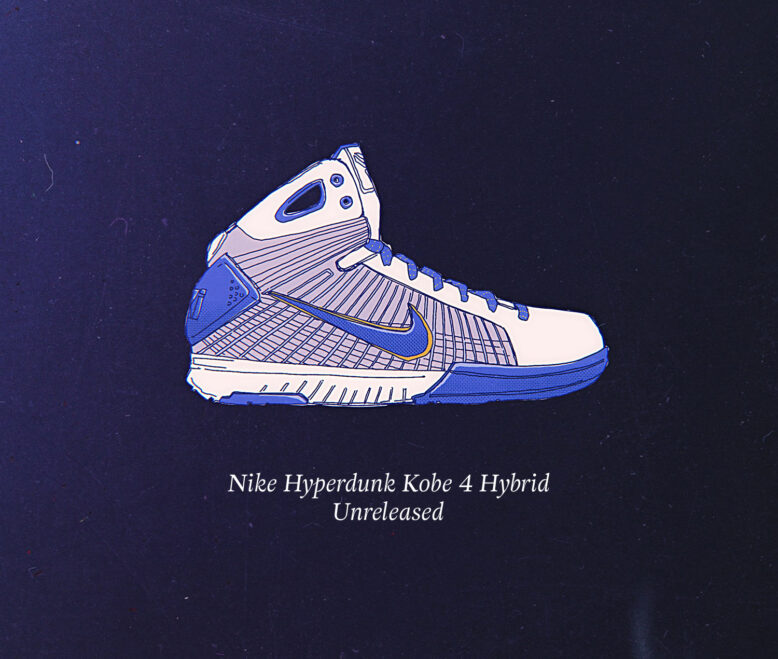
The Olympics provided the perfect stage to unveil the HyperDunk to the world, with nearly all Nike-sponsored athletes and teams wearing their versions. However, Kobe had his own colorway, featuring textures and illustrations throughout the shoe, along with his logo on the tongue. Returning to the NBA regular season, Kobe continued to wear the HyperDunk for several months and even tested a hybrid version, combining the upper of the HyperDunk with the midsole of his upcoming shoe, the Kobe 4, to weartest the new model that would once again revolutionize the basketball world.
Curiosity
While talking with Jeff Staple in his office in New York, he mentioned that he had worked on a special colorway of the Kobe II. We couldn’t get much information about it, but it’s interesting that he had some connection to the model.
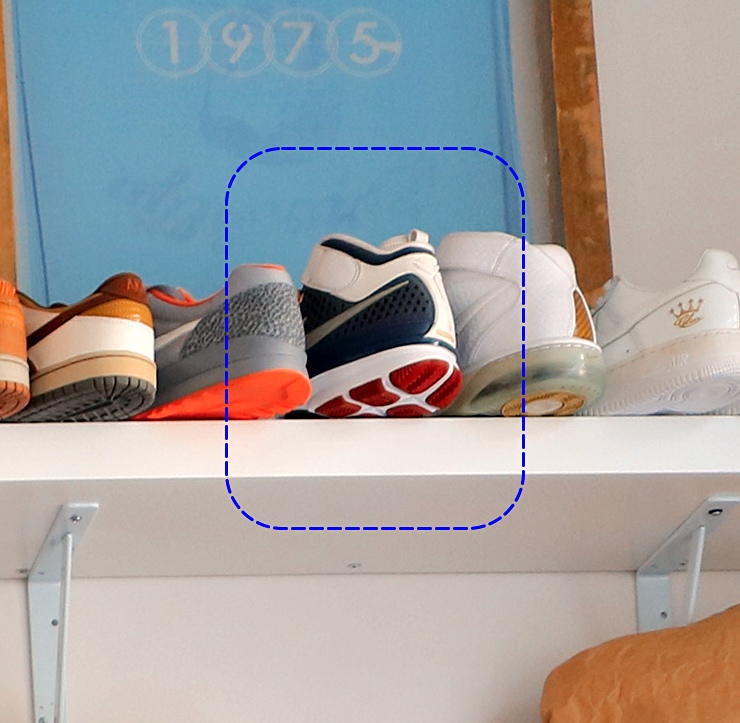
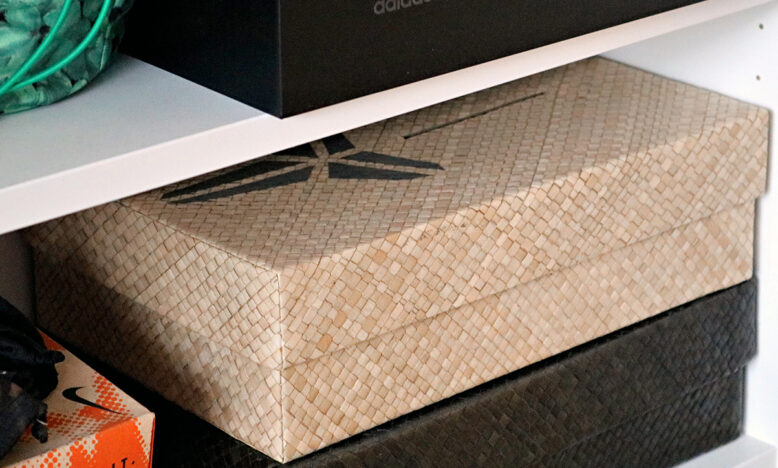
The Dream Team
In 1989, FIBA changed the rules to allow NBA professional players to compete in the Olympics. This was a precursor to what would come in the 1992 Olympics, simply the best and most complete basketball team in history. The team featured names like Larry Bird, Scottie Pippen, Karl Malone, Magic Johnson, and none other than Michael Jordan. With so many stars, the American team became known as the Dream Team. Their dominance was so great that they won every game with an average victory margin of 44 points over their opponents, with the smallest margin being 32 points in the final against Croatia. Of the 12 athletes on the Dream Team roster, 10 were named in 1996 among the top 50 greatest players in NBA history. To top it all off, Michael Jordan and Scottie Pippen became the first to win both an NBA Championship and Olympic gold medal in the same year while playing for the Chicago Bulls.
Defeat in 2002, 2004, and 2006
With the possibility of using NBA stars in the Olympics, the United States began to approach the tournament with even more ease and confidence. However, in 2004, coming off a loss at the 2002 World Championship, the team needed to win to maintain its dominance. Haunted by September 11 and the Iraq War, many American basketball stars refused to go to the Olympics, and the U.S. team was assembled in a hurry, featuring young rookies at the time like Dwyane Wade, LeBron James, and Carmelo Anthony, along with stars like Tim Duncan and Allen Iverson.
Right from the first game, a sign of what was to come: a loss to Puerto Rico. On August 27, 2004, in the semifinals, Argentina, which would go on to win the gold, defeated the heavily favored United States 89 to 81, led by the Spurs shooting guard, Manu Ginóbili, who scored 29 points.
After the disappointing result in Athens, the Americans wanted to reclaim the title and the honor of being the best team in the world. So, USA Basketball made Jerry Colangelo as its new director and Mike Krzyzewski, Coach K, the head coach at Duke University, as its new head coach. In addition to the changes in management, the team was built within a long-term project, unlike previous years where they came together right before the competition. This time, the goal was to form a team, not just assemble great stars and play any which way. The first big test for this new team was the 2006 World Championship, and once again, they suffered another defeat, this time to Greece in the semifinals. Following this negative result, the American team needed to secure a spot for Beijing in the 2007 America’s Cup, and they concluded that they were in need of a big star in their lineup, specifically the top player in the NBA at that time: Kobe Bryant.

Kobe Bryant and the Redeem Team
Kobe arrived at the national team with the mission of elevating the level and being the great leader of the roster. He would finally compete in an Olympics after having declined to attend the Sydney Games in 2000 and the Athens Games in 2004. However, despite being the leading figure in basketball at that moment, the star was surrounded by controversies that led Americans to question whether he could deliver. The quality of the Los Angeles Lakers star was never in doubt, but his on-court style, viewed by many as selfish, along with his influence in Shaquille O’Neal’s trade from the Lakers to the Heat, put the star under scrutiny. For Kobe, this was the perfect opportunity to break all the labels placed on him, and for the American team, a great chance to rise again.
After the loss at the World Championship, USA Basketball needed the America’s Cup Qualifiers to go to Beijing and fulfilled its duty by qualifying for the Olympics, which could restore the honor of American basketball. The team was composed of stars like LeBron James, Carmelo Anthony, Dwyane Wade, Chris Bosh, Jason Kidd, Dwight Howard, Chris Paul, and its main star, the main weapon for their return to glory: Kobe Bryant.
Upon arriving in China, Kobe was celebrated and pursued by fans. But even with the excitement, the star remained focused, serving as a role model for the entire group, both in practice and in daily life. In the preliminary round, the United States excelled, with the closest victory being by 21 points against Angola. In the elimination rounds, they comfortably defeated Australia and Argentina. In the final, they faced the formidable Spanish team again, in an extremely even match. However, when Spain managed to cut the lead to two points, Kobe stepped up and hit several consecutive shots, notably an epic three-pointer and a foul, silencing the crowd, showing that the game was under control and that the United States would win. In the end, the game concluded with an 11-point advantage for the Americans and the gold medal. Thus, the United States finally reclaimed its dominance in basketball, and the historic 2008 team became known as the Redeem Team.
Current Generation
With a fourth-place finish at the 2023 World Championship, the team once again gathered its top stars to reclaim its dominance, and succeeded. The squad headed to Paris with full force and a new Dream Team, featuring: LeBron James, Stephen Curry, Kevin Durant, Joel Embiid, Anthony Edwards, Anthony Davis, Devin Booker, Jayson Tatum, Jrue Holiday, Bam Adebayo, and Tyrese Halliburton, aiming for gold. Since their victory in 2008, the United States has never lost an Olympic Games, winning in 2012, 2016, 2020, and now 2024.
